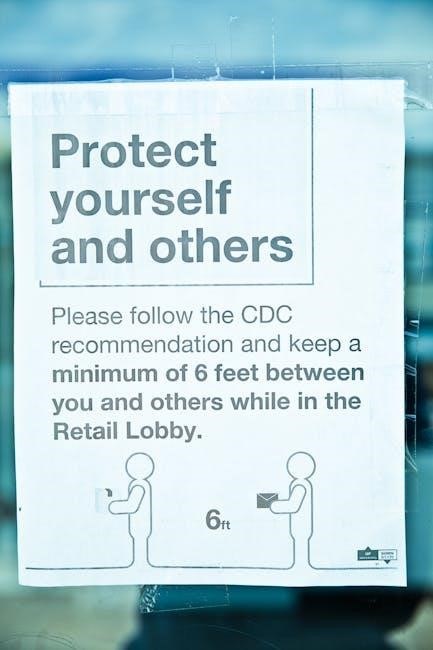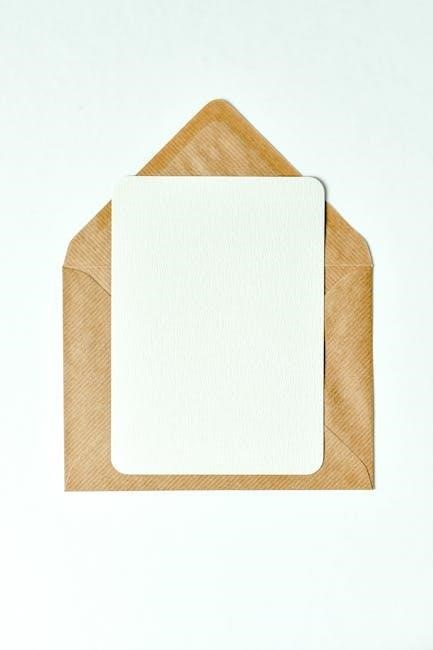Overview of Spanish Post-Op Instructions for Extractions
Spanish post-op instructions for extractions emphasize proper wound care and rest to prevent complications. Following these guidelines ensures a smooth recovery and protects the healing process effectively.
Importance of Following Post-Operative Care
Following post-operative care instructions after a tooth extraction is crucial for preventing complications and ensuring proper healing. Neglecting these guidelines can lead to infection, prolonged bleeding, or dry socket, delaying recovery. Adhering to the recommended rest, diet, and hygiene practices helps maintain a clean environment for the wound to heal. Proper care also minimizes discomfort and reduces the risk of further medical interventions. By prioritizing these steps, patients can achieve a smoother and faster recovery, ensuring the success of the extraction procedure and overall oral health. Consistency and attention to detail are key to avoiding setbacks and promoting optimal healing outcomes.
General Guidelines for Recovery
General recovery guidelines after tooth extraction emphasize rest, proper nutrition, and avoiding strenuous activities. Patients should adhere to a soft-food diet, avoid smoking, and limit alcohol consumption. Maintaining oral hygiene through gentle rinsing and brushing is essential, but direct pressure on the extraction site should be avoided. Resting adequately and managing pain with prescribed medications helps promote healing. Following these guidelines ensures a comfortable recovery, reduces the risk of complications, and supports the body’s natural healing process. Consistency in these practices is key to achieving optimal results and minimizing discomfort during the recovery period.
Immediate Post-Extraction Care
After extraction, bite firmly on gauze for 30-45 minutes to control bleeding. Avoid dislodging the clot, apply ice to reduce swelling, and rest for 24 hours.
Managing Bleeding and Swelling
After extraction, bite firmly on the gauze for 30-45 minutes to control bleeding. If bleeding persists, replace the gauze or use a clean cloth. Apply ice packs to the affected area for 15-20 minutes every hour to reduce swelling. Avoid strenuous activities, bending, or spitting, as these can dislodge the clot. Keep your head elevated while resting to minimize swelling. Do not rinse your mouth vigorously or drink through a straw. Follow these steps to promote healing and prevent complications.
Using Gauze and Ice Packs
Place the provided gauze over the extraction site and bite down gently for 30-45 minutes to stop bleeding. If bleeding continues, replace the gauze with a clean one. Apply an ice pack to the outer cheek near the extraction site for 15-20 minutes, repeating every hour, to reduce swelling. Avoid direct contact between the ice and skin to prevent irritation. These steps help stabilize the blood clot and minimize discomfort during the initial healing phase, ensuring proper recovery and reducing the risk of complications.

Pain Management
Managing discomfort after extraction is crucial for recovery. Use prescribed pain relievers as directed and follow the dosage instructions provided by your healthcare provider to ensure proper healing and minimize discomfort effectively.
Recommended Medications
For pain management after extraction, medications like ibuprofen or naproxen are commonly recommended to reduce inflammation and discomfort. In some cases, prescription pain relievers may be prescribed. Antibiotics might be advised to prevent infection. Always follow the dosage instructions provided by your dentist or healthcare provider. Avoid combining medication with alcohol, as it can interfere with healing. If pain persists or worsens, consult your healthcare provider promptly. Adhering to the prescribed medication regimen ensures proper healing and minimizes post-operative discomfort effectively.
Dosage and Frequency Instructions
Medications should be taken as directed by your healthcare provider. For pain relief, ibuprofen or naproxen are often recommended, typically every 6-8 hours. Antibiotics, if prescribed, must be taken as instructed to prevent infection. Do not exceed the recommended dosage or skip doses. Avoid consuming alcohol while on medication, as it can hinder healing. If pain persists or worsens, contact your provider immediately. Adhering to the prescribed dosage and frequency ensures effective recovery and minimizes potential side effects. Always follow the instructions provided to promote proper healing and avoid complications.

Dietary Recommendations
Stick to soft foods like yogurt, soup, and scrambled eggs immediately after extraction. Gradually introduce semi-soft foods as healing progresses. Avoid hard or crunchy foods to prevent injury.
Soft Foods to Eat After Extraction
Opt for soft, non-irritating foods like yogurt, mashed potatoes, and scrambled eggs. Soups, smoothies, and soft-cooked pasta are also ideal. Avoid chewing directly over the extraction site. Incorporate nutrient-rich options such as pureed fruits and vegetables to support healing. Soft foods minimize discomfort and prevent dislodging the blood clot. Avoid extreme temperatures to prevent irritation. Gradually introduce softer versions of your usual diet as recovery progresses. A balanced diet aids in tissue repair and strength. Stick to these recommendations to ensure proper healing and minimize the risk of complications during recovery.
Foods to Avoid During Recovery
It is crucial to avoid hard, crunchy, or sharp foods that could irritate the extraction site or dislodge the blood clot. Avoid chewing ice, nuts, chips, or raw vegetables. Spicy, acidic, or hot foods can also cause discomfort. Do not consume alcohol or caffeine, as they may interfere with healing or interact with medications. Avoid using straws, as the suction can dislodge the clot. Hard or sticky candies, popcorn, and seeds should also be avoided; Wait until healing is complete before resuming these foods to prevent complications and ensure proper recovery.
Nutritional Advice for Healing
A balanced diet is essential for recovery after tooth extraction. Opt for soft, nutrient-rich foods like scrambled eggs, yogurt, and mashed potatoes. Include lean proteins such as chicken or fish, cooked until tender. Incorporate fruits and vegetables rich in vitamins A and C, such as bananas, applesauce, and steamed vegetables, to promote healing. Whole grains like oatmeal or rice provide necessary fiber. Stay hydrated with water, herbal teas, or clear broths. Avoid sugary or acidic drinks that may irritate the extraction site. A diet high in calcium, such as dairy products, can support bone healing. Prioritize easily chewable foods to minimize discomfort and aid recovery.
Oral Hygiene Instructions
Maintain good oral hygiene by gently rinsing with warm saltwater starting 24 hours after extraction. Brush teeth softly, avoiding the extraction site, and use mild products to prevent irritation.
Proper Rinsing Techniques
Start rinsing with warm saltwater 24 hours after extraction to promote healing. Mix 1 teaspoon of salt in 8 ounces of warm water. Gently swish the solution around your mouth for 30 seconds, focusing on the extraction site. Avoid vigorous rinsing to prevent dislodging the blood clot. Repeat this process 2-3 times daily, especially after meals, to keep the area clean. Do not use harsh mouthwashes or hydrogen peroxide, as they can irritate the wound. Gentle rinsing helps remove debris and reduces the risk of infection, supporting a smooth recovery.
Brushing Teeth Gently
After an extraction, brush your teeth gently to maintain oral hygiene without disrupting the healing process. Use a soft-bristle toothbrush and mild toothpaste, avoiding the extraction site. Brush the surrounding teeth carefully to remove plaque and bacteria. Avoid using electric toothbrushes or harsh products that could irritate the area. Resume normal brushing gradually after 3-4 days, but continue to be cautious around the extraction site. Proper brushing prevents infection and promotes healing, ensuring a comfortable and smooth recovery process.
Smoking and Alcohol Consumption
Smoking and alcohol consumption should be avoided after tooth extraction to prevent complications. Both can delay healing, increase pain, and lead to infection or dry socket formation.
Risks of Smoking After Extraction
Smoking after tooth extraction significantly increases the risk of complications, such as dry socket and infection. Nicotine and toxins in smoke delay healing, reduce blood flow, and weaken the immune response. Smoking can dislodge the blood clot, leading to prolonged pain and delayed recovery. Additionally, it increases the likelihood of post-operative infections and may impair the effectiveness of prescribed medications. Patients are strongly advised to avoid smoking entirely during the recovery period to ensure proper healing and minimize risks; Even occasional smoking can negatively impact the healing process.
Alcohol Consumption Guidelines
Alcohol consumption should be avoided during the recovery period after tooth extraction. Alcohol can interfere with blood clotting, delay healing, and increase the risk of bleeding or infection. It is recommended to refrain from drinking alcohol for at least 24 to 48 hours post-procedure. Additionally, alcohol can interact negatively with pain medications, reducing their effectiveness and potentially causing adverse side effects. Patients are advised to adhere to this guideline to ensure a safe and smooth recovery process. Complete avoidance of alcohol during the initial healing phase is strongly encouraged for optimal results.

Activity Level and Rest
After extraction, rest is crucial for healing. Avoid strenuous activities for 24-48 hours. Excessive movement can dislodge the clot, leading to bleeding or discomfort. Mild exercise can resume gradually.
Recommended Physical Activity Levels
After tooth extraction, it’s essential to balance rest and light physical activity. Patients should avoid strenuous exercises for 24-48 hours to prevent dislodging the blood clot. Gentle movements like walking are acceptable, but heavy lifting, bending, or intense workouts should be avoided. Resting allows the body to heal efficiently, reducing the risk of complications. Gradually resume normal activities as comfort permits, ensuring not to overexert. Listening to your body and maintaining a calm, stress-free environment supports recovery. Avoid activities that could disrupt the healing process and consult your dentist if discomfort persists.
Importance of Rest for Healing
Rest is crucial after tooth extraction to promote healing and minimize complications. Lying down or keeping the head elevated helps reduce swelling and bleeding. Avoiding strenuous activities for 24-48 hours ensures the blood clot remains intact. Overexertion can dislodge the clot, leading to dry socket or prolonged recovery. Rest allows your body to focus its energy on healing the extraction site. A calm and stress-free environment supports recovery. Adequate rest also reduces pain and inflammation, making the healing process smoother. Prioritizing rest helps your body recover naturally and effectively after the procedure.

Follow-Up Appointments
Follow-up appointments are essential to monitor healing progress and address any concerns. They ensure proper recovery and prevent potential complications after tooth extraction procedures.
When to Schedule a Follow-Up
A follow-up appointment should typically be scheduled 7-10 days after the extraction to monitor healing progress. Patients should also seek immediate follow-up if they experience signs of infection, dry socket, or unusual bleeding. Early follow-up may be necessary for patients with complex extractions or underlying health conditions. Additionally, follow-ups are crucial for suture removal, if applicable, and to ensure proper healing of the extraction site. Adhering to the dentist’s recommended schedule helps prevent complications and ensures a smooth recovery process. Regular check-ups are vital for maintaining oral health post-extraction.
What to Expect During Follow-Up
During a follow-up appointment, the dentist will examine the extraction site to ensure proper healing and check for any signs of complications. Patients can expect a visual inspection of the wound, and in some cases, gentle probing to assess tissue recovery. If sutures were placed, they may be removed during this visit. The dentist will also provide feedback on the healing progress and address any concerns or questions. Additionally, further instructions may be given to continue caring for the extraction site. This visit is crucial for confirming that the healing process is on track and addressing any potential issues early.

Monitoring for Complications
Monitor for signs of infection, prolonged bleeding, or severe pain. Watch for redness, swelling, or delayed healing. Contact your dentist immediately if unusual symptoms arise.
Signs of Infection
Infection after tooth extraction may cause redness, swelling, pus, fever, or a bad taste in the mouth. If symptoms worsen or persist, consult your dentist immediately. Delayed healing or severe pain can also indicate infection. Monitor for unusual discharge or foul odor. Early detection is crucial to prevent complications. Contact your healthcare provider if you experience any of these signs to ensure proper treatment and avoid prolonged recovery. Prompt medical attention can address infections effectively, ensuring a smooth healing process.
Recognizing Dry Socket Symptoms
Dry socket, or alveolar osteitis, occurs when the blood clot dislodges, exposing the bone and nerve endings. Symptoms include intense pain, often radiating to the ear or neck, and an empty, crater-like appearance in the socket. Bad breath or a foul taste may also be present. If you notice these signs, contact your dentist promptly. Early detection is key to preventing prolonged discomfort. Proper treatment can alleviate symptoms and promote healing. Recognizing these indicators ensures timely intervention, reducing the risk of complications and supporting a faster recovery process.

Spanish Language Resources
Spanish-language medical websites offer detailed post-op extraction guides, ensuring clear communication for Spanish-speaking patients. These resources include instructional videos and downloadable PDFs for easy access and understanding.
Spanish-Language Post-Op Instructions
Spanish-language post-op instructions for extractions are tailored to ensure clear communication for Spanish-speaking patients. These resources include translated medical terminology, step-by-step recovery guides, and visual aids like diagrams or videos. Many healthcare providers offer downloadable PDFs or online access to these instructions, making them easily accessible. Cultural considerations are also integrated to address specific patient needs. By providing detailed information in Spanish, these materials help reduce misunderstandings and improve adherence to recovery protocols. They cover key topics such as pain management, dietary advice, and hygiene practices, ensuring patients can follow instructions accurately for optimal healing outcomes.
Cultural Considerations in Recovery
Cultural considerations play a significant role in Spanish post-op recovery, ensuring that instructions resonate with diverse patient backgrounds. Providers often incorporate traditional practices and dietary preferences into recovery plans. For instance, recommending soft, culturally familiar foods like soups or rice dishes can enhance patient comfort. Language barriers are addressed through bilingual support staff or translated materials. Additionally, respecting cultural attitudes toward pain management and recovery timelines helps build trust between patients and healthcare providers. These tailored approaches promote better adherence to post-op instructions and improve overall patient satisfaction during the healing process, fostering a more inclusive care environment.

Additional Tips
Consider saltwater rinses to reduce swelling and promote healing. Stay hydrated to aid recovery and avoid discomfort. Chew sugar-free gum to stimulate saliva flow gently.
Using Saltwater Rinses
Saltwater rinses are recommended to reduce swelling and promote healing after extraction. Dissolve 1 teaspoon of salt in warm water, swish gently, and repeat 2-3 times daily. Avoid vigorous rinsing to prevent dislodging the clot. Start rinses 24 hours post-procedure for optimal benefits. This natural remedy helps keep the area clean and reduces the risk of infection. Pair with gentle brushing for effective oral care during recovery.
Staying Hydrated
Staying hydrated is crucial after tooth extraction to support healing and prevent dehydration. Drink plenty of water and consider herbal teas or clear broths. Avoid alcohol, caffeine, and carbonated drinks for 24-48 hours. Start with small sips a few hours post-procedure, gradually increasing intake. Proper hydration helps maintain blood flow to the extraction site, promoting faster recovery. Dehydration can slow healing and cause discomfort, so prioritize fluid intake. Use a cup instead of a straw to avoid dislodging the clot. Keeping the body well-hydrated ensures the best outcomes and minimizes post-operative discomfort.
Spanish post-op instructions for extractions are designed to ensure a safe and efficient recovery. Proper care and adherence to guidelines minimize complications, promoting optimal healing outcomes.
Adhering to Spanish post-op instructions ensures a smooth recovery after tooth extractions. Key points include managing pain, following dietary guidelines, maintaining oral hygiene, and avoiding smoking or alcohol. Rest is crucial, as is attending follow-up appointments. Monitoring for signs of complications, like infection or dry socket, is essential. Proper wound care and avoiding strenuous activities promote healing. Staying hydrated and using saltwater rinses can aid recovery. By following these guidelines, patients can minimize risks and achieve optimal healing outcomes. Consistency and attention to detail are vital for a successful post-operative period.
Final Tips for a Smooth Recovery
- Adhere strictly to post-operative instructions provided by your dentist or surgeon to minimize complications.
- Stay hydrated by drinking plenty of fluids, especially water, to support the healing process.
- Use saltwater rinses daily to maintain oral hygiene and promote healing.
- Avoid smoking and alcohol consumption for at least 72 hours to prevent delayed healing or dry socket.
- Rest adequately and avoid strenuous activities to allow your body to recover effectively.
- Follow the recommended medication schedule to manage pain and reduce inflammation.
- Attend all follow-up appointments to ensure proper healing and address any concerns.
By following these tips, you can ensure a smooth and complication-free recovery after your extraction.

Additional Resources
Spanish-language medical websites like SECOM and AADPA offer detailed post-op guides. Apps like Recupera track recovery progress, while support groups provide emotional assistance during healing.
Spanish-Language Medical Websites
Spanish-language medical websites like SECOM and AADPA provide comprehensive post-op care guides. These sites offer detailed instructions, downloadable PDFs, and video tutorials for patients. They cover topics like wound care, pain management, and dietary advice, ensuring clear communication for Spanish-speaking patients. Additionally, these platforms often include FAQs and forums where patients can ask questions and share experiences. Patients are encouraged to bookmark these resources for easy access during their recovery period. These websites are trusted sources for reliable, culturally relevant information tailored to Spanish-speaking individuals undergoing extraction procedures.
Recommended Apps for Recovery Tracking
For Spanish-speaking patients, apps like RecuperaApp and CuidaTuSalud offer tools to track recovery progress. These apps provide medication reminders, pain tracking, and dietary advice. They also allow users to set reminders for follow-up appointments and log symptoms or concerns. Designed for Spanish-speaking patients, these apps ensure clear communication and cultural relevance. Features like progress tracking and motivational messages help patients stay engaged in their recovery journey. These apps are valuable resources for monitoring healing and maintaining open communication with healthcare providers.
Support Groups for Patients
Support groups provide emotional and practical support during recovery. Spanish-speaking patients can join groups like Grupos de Apoyo Postoperatorio or Recuperación Oral. These communities share experiences, offer advice, and help reduce anxiety. Online forums and social media groups, such as Comunidad de Recuperación, also offer accessible support. These platforms allow patients to connect with others who have undergone similar procedures, fostering a sense of camaraderie and understanding. Support groups play a vital role in helping patients stay motivated and informed throughout their recovery journey.
Consulting with a Healthcare Professional
Consulting a healthcare professional is crucial for personalized recovery plans. They provide tailored advice, address concerns, and monitor healing progress. Regular follow-ups ensure complications are caught early. Spanish-speaking patients can access resources like Guías Médicas en Español for clear guidance. Professionals may adjust medications or dietary recommendations based on individual needs. Open communication with your doctor helps prevent issues like infection or dry sockets. Utilizing Spanish-language medical websites, such as Consulta Médica, ensures patients understand their care plan fully. This support network is essential for a safe and effective recovery process.

Final Thoughts
Adhering to Spanish post-op instructions for extractions is vital for a successful recovery. By following guidelines on pain management, diet, and oral hygiene, patients can minimize complications. Consulting healthcare professionals ensures personalized care, while resources like Guías Médicas en Español provide clear, culturally relevant information. Prioritizing rest and avoiding harmful habits, such as smoking, supports healing. Staying hydrated and using saltwater rinses can also aid recovery. Remember, proper care post-extraction leads to better outcomes and a faster return to normal activities. Always seek professional advice for any concerns to ensure a smooth and safe recovery process.


